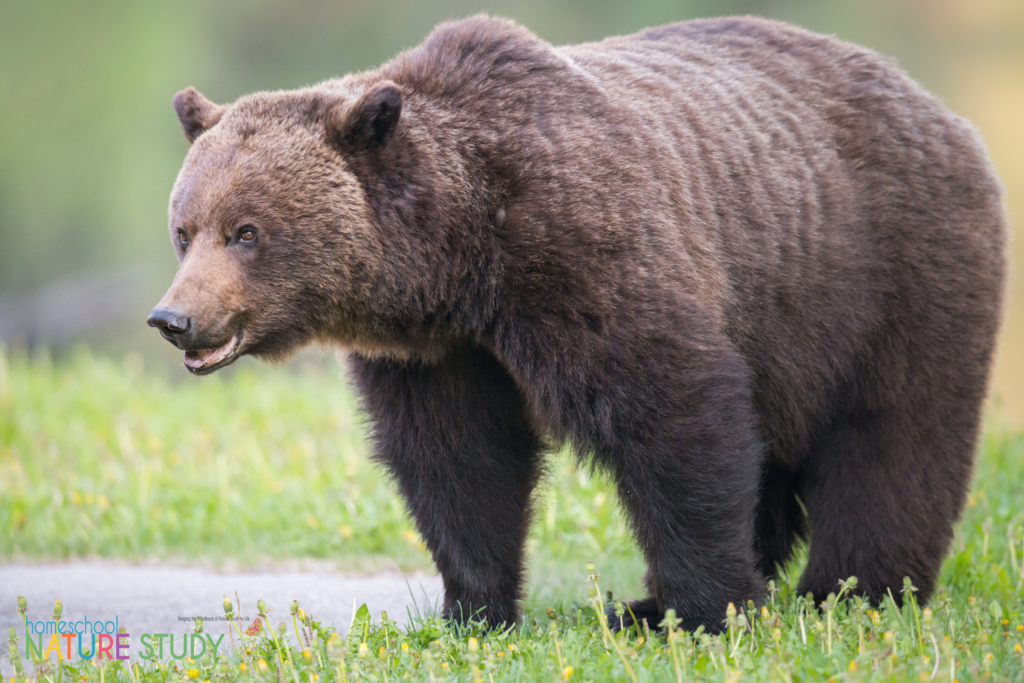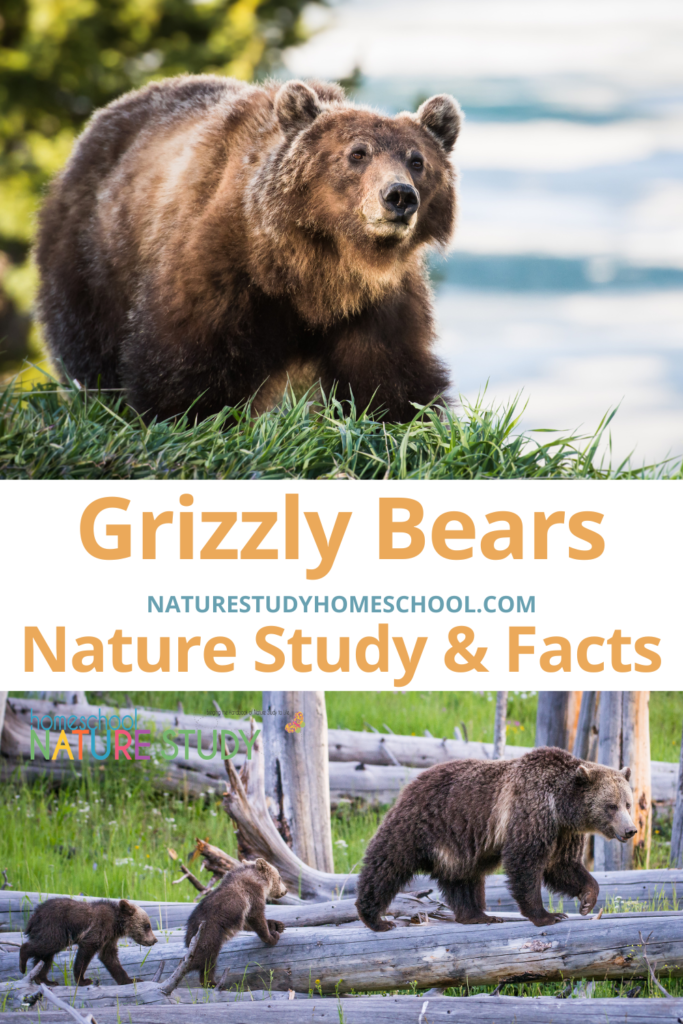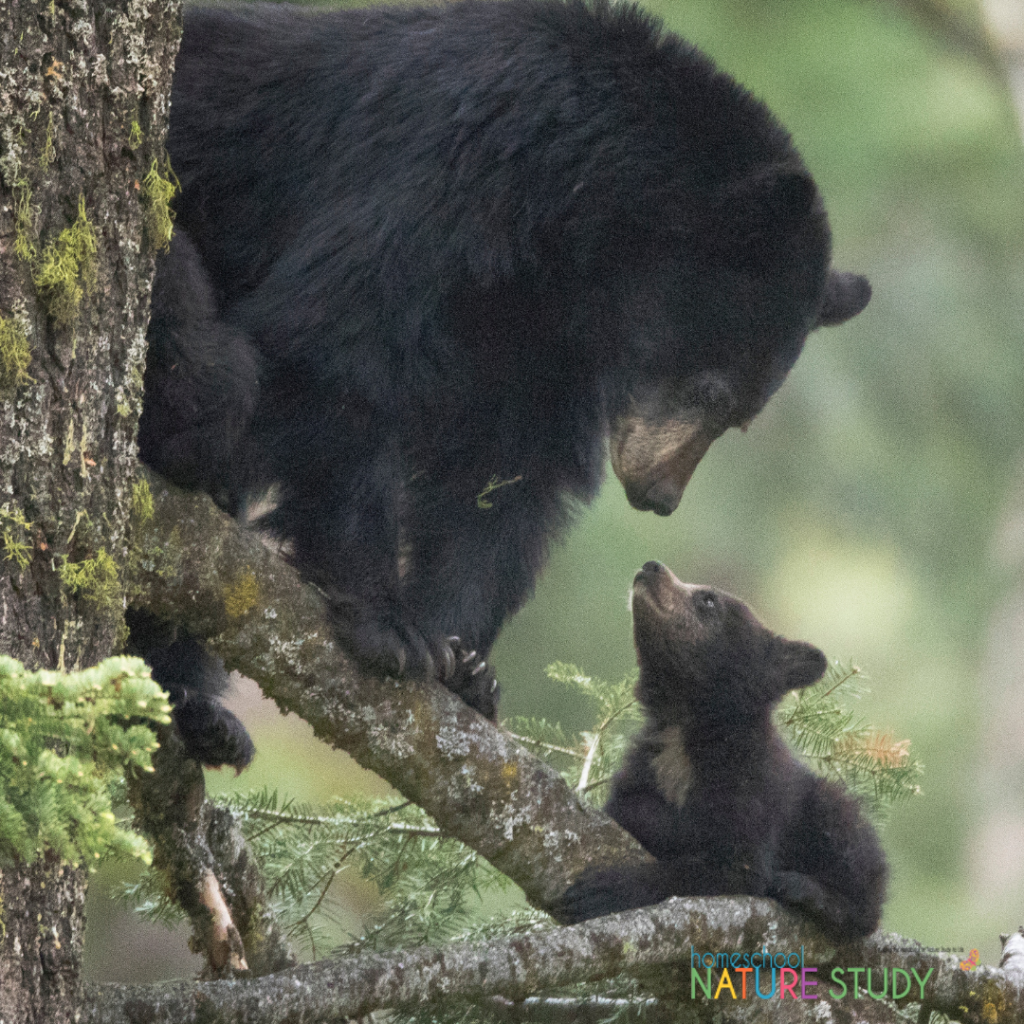Go wild with a Grizzly Bears Nature Study! Fun facts and Barb’s grizzly encounter at the Grand Tetons National Park.

Grizzly bears were once abundant across the United States. They are currently listed as a threatened species under the Endangered Species Act (ESA) in the lower 48 states. There are eight different species of bears. Learn more about this north western creature with your own Grizzle Bear Nature Study.
Grizzly Bears: Nature Study and Fun Facts
Grizzly Bears have a distinctive hump on their shoulders that’s actually a powerful muscle used for digging and running.
Grizzly Bears can weigh over 800 pounds and measure 5 to 8 feet long. Adult males can stand nearly 10 feet tall when upright. This is still considered smaller compared to a polar bear!
Grizzly Bears have short round ears while other bears tend to have pointy ears.
Grizzly Bears have long claws while other bears have shorter claws.
Grizzly Bears can be many colors, including: light tan, blonde, reddish, dark brown, and almost black.
Grizzly Bears live in a variety of habitats, including prairies, mountains, meadows, forests, and tundra.
Grizzly Bears live about 20-25 years.
Female Grizzly Bears can give birth to 2-4 cubs in late January or February. Cubs stay with their mother for 2-5 years.
Grizzly bears enter a state similar to hibernation, called torpor, during the winter.

Where do grizzly bears live?
Grizzly bears are found today in Alaska, Wyoming, Montana, Idaho, Washington as well as British Columbia, Alberta, the Yukon, Northwest Territories, Nunavut, and northern part of Manitoba in Canada.
Barb’s Grizzly Encounter in Grand Teton National Park
Outdoor Hour Challenge founder, Barb McCoy, encountered a grizzly bear while traveling with her family. She shares, here: “In July 2011 we were driving through the Teton National Park at sunset and we thought at first that we saw a bison. At second glance we realized it was a bear!
You can see in this photo that other people were not using good judgement and they were way too close to the bears. These are really big bears and I know that there is nothing like a mama bear protecting her cubs….
It was a wonderful experience to see these creatures in their natural environment. The cubs were sort of playing with each other as they romped through the meadow. The mama was walking with that bear sort of swagger that is so distinctive. Amazing to see just how big they are in real life.
Just another Wyoming experience.”

Grizzly Bear Notes Printable for Members

Homeschool Nature Study Members can head over to their dashboard to print the new Grizzly Bears Notes worksheet. This is a fun worksheet to fill in after visiting the zoo, a bear sanctuary, reading a book about bears, and/or watching a documentary on grizzly bears. Or spend a few minutes watching the Katmai National Park Bear Cam (this is a highlight reel from the year).

More Bear and Mammal Nature Studies for Your Homeschool
You might have a different type of bear in your part of the world, or you might like to learn about other mammals. Here are more resources to explore:
Black Bear Study for Your Homeschool – You can enjoy some forest fun nature studies in your homeschool and do a bear nature study Outdoor Hour Challenge. Includes hands on art and links for further bear studies.
You can enjoy a Homeschool Nature Study with Winnie the Pooh’s Hundred Acre Wood as well. Paint a map of the Hundred Acre Wood, have a Teddy Bear Picnic and more.
In our Animal Tracks Nature Hunt, you can use these nature study lesson plans, suggestions, ideas and resources for identifying animal tracks!
Join the Homeschool Nature Study Membership
You’ll find a detailed bear nature study challenge in the Forest Fun course that’s available with Homeschool Nature Study Membership. This study also includes advanced studies for high school students with notebooking pages and suggestions for learning about bear communication.
There are so many benefits to joining. You will access our full range of curriculum, our interactive learning calendar as well as homeschool nature study challenges for each week!
Original post written by Barb 2020, updated by Stef Layton 2024.




I would have just put the window down and took my picture from the car. I wouldn’t want to see one of them up close.
How amazing to get to see such beautiful animals! I’m glad that you wisely kept a safe distance. We only have black bears in our state, and even those are seldom seen in the wild in our area (more are in the mountains), but I enjoy seeing the rescued bears at our local science museum. They’re so interesting to watch and learn from! — Kathy at http://www.needleandspade.com
Here in the Smokies we have tourists that use extremely bad judgment with getting too close to our black bears. We had people once who had their 6 year old trying to pet one. Although they are not quite as aggressive as a grizzly, black bears with cubs can be very defensive. I wish people had gotten in the right line when the good Lord handed out common sense lol. ~ Nikki
I remember being out in Yellowstone and people getting so, so close to huge elk.
Great pictures!! Thanks for sharing them!
I am in absolute awe!
We considered a trip to the Tetons and Yellowstone this year, but had to change our plans. Our family would love to see a bear in the wild – but definitely from a distance!!!
Thanks for sharing your Wyoming experiences. Great photos. I am continually amazed at what humans do!
beautiful!! I was just popping over to share some shots of a bear that was in my yard yesterday too! (just a much smaller black bear and her cubs)
Wow! So nice you got to see all three – safely. We missed seeing bears this trip to Wyoming. I’m thinking we need another trip to Alaska.
Amazing and beautiful! During our trip to the Rockies this spring we were dismayed to see people getting so close to the animals as well. It’s as though people forget that they *are* animals, not just photo subjects! My camera has a good zoom for a reason. 😉